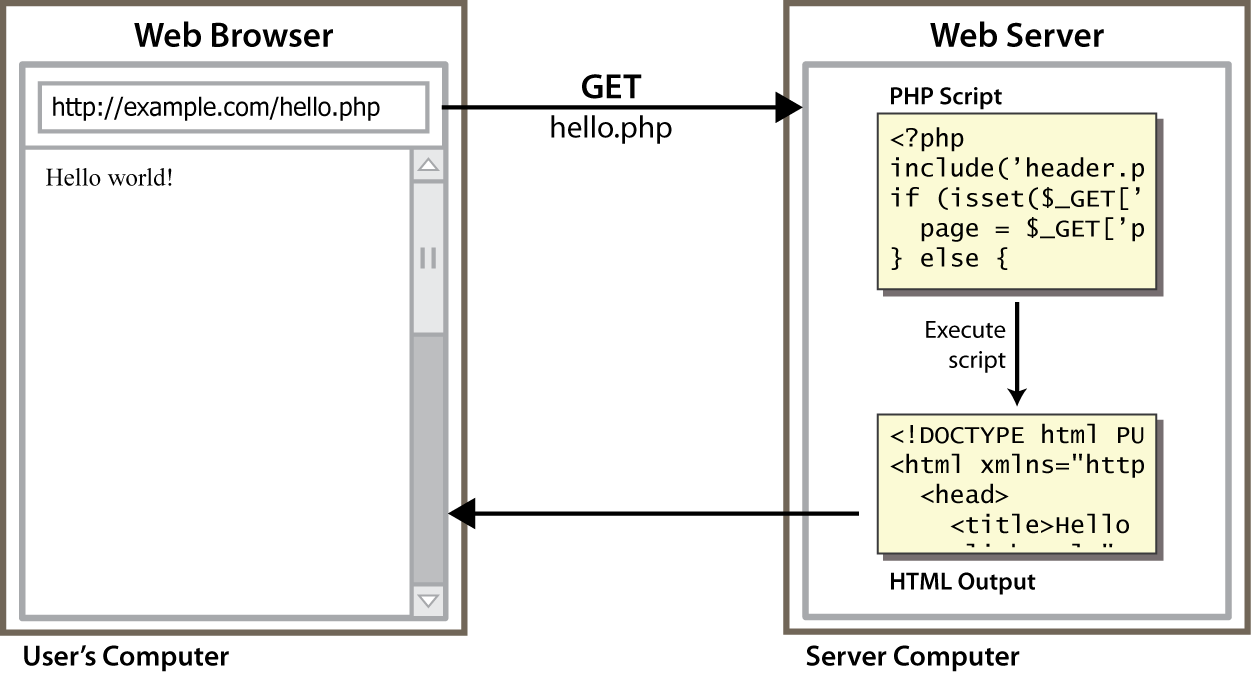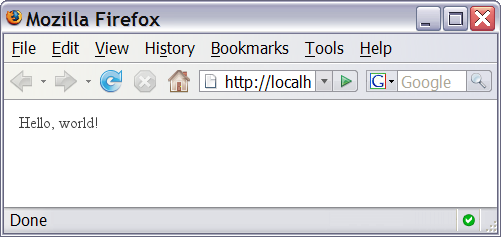Web Programming Step by Step
Lecture 6-B
Introduction to PHP
Reading: 5.1 - 5.2
Except where otherwise noted, the contents of this presentation are Copyright 2010 Marty Stepp and Jessica Miller.
5.1: Server-Side Basics
- 5.1: Server-Side Basics
- 5.2: PHP Basic Syntax
- 5.3: Embedded PHP
- 5.4: Advanced PHP Syntax
URLs and web servers
http://server/path/file
- usually when you type a URL in your browser:
- your computer looks up the server's IP address using DNS
- your browser connects to that IP address and requests the given file
- the web server software (e.g. Apache) grabs that file from the server's local file system, and sends back its contents to you
- some URLs actually specify programs that the web server should run, and then send their output back to you as the result:
https://webster.cs.washington.edu/cse190m/quote.php
- the above URL tells the server
webster.cs.washington.eduto run the programquote2.phpand send back its output
- the above URL tells the server
Server-Side web programming




- server-side pages are programs written using one of many web programming languages/frameworks
- the web server contains software that allows it to run those programs and send back their output
- each language/framework has its pros and cons
- we use PHP for server-side programming in this textbook
What is PHP? (5.1.2)

- PHP stands for "PHP Hypertext Preprocessor"
- a server-side scripting language
- used to make web pages dynamic:
- provide different content depending on context
- interface with other services: database, e-mail, etc
- authenticate users
- process form information
- PHP code can be embedded in XHTML code
Lifecycle of a PHP web request (5.1.1)

- browser requests a
.htmlfile (static content): server just sends that file - browser requests a
.phpfile (dynamic content): server reads it, runs any script code inside it, then sends result across the network- script produces output that becomes the response sent back
Why PHP?
There are many other options for server-side languages: Ruby on Rails, JSP, ASP.NET, etc. Why choose PHP?
- free and open source: anyone can run a PHP-enabled server free of charge
- compatible: supported by most popular web servers
- simple: lots of built-in functionality; familiar syntax
- available: installed on UW's servers (Dante, Webster) and most commercial web hosts
- well-documented: type
php.net/functionNamein browser Address bar to get docs for any function
Hello, World!
The following contents could go into a file hello.php:
<?php print "Hello, world!"; ?>
Hello, world!
- a block or file of PHP code begins with
<?phpand ends with?> - PHP statements, function declarations, etc. appear between these endpoints
Viewing PHP output


- you can't view your
.phppage on your local hard drive; you'll either see nothing or see the PHP source code - if you upload the file to a PHP-enabled web server, requesting the
.phpfile will run the program and send you back its output
5.2: PHP Basic Syntax
- 5.1: Server-Side Basics
- 5.2: PHP Basic Syntax
- 5.3: Embedded PHP
- 5.4: Advanced PHP Syntax
Console output: print
(5.2.2)
print "text";
print "Hello, World!\n"; print "Escape \"chars\" are the SAME as in Java!\n"; print "You can have line breaks in a string."; print 'A string can use "single-quotes". It\'s cool!';
Hello, World!
Escape "chars" are the SAME as in Java!
You can have
line breaks in a string.
A string can use "single-quotes". It's cool!
- some PHP programmers use the equivalent
echoinstead ofprint
Arithmetic operators (5.2.4)
-
+ - * / %
. ++ --
= += -= *= /= %= .=
- many operators auto-convert types:
5 + "7"is12
Variables (5.2.5)
$name = expression;
$user_name = "PinkHeartLuvr78"; $age = 16; $drinking_age = $age + 5; $this_class_rocks = TRUE;
- names are case sensitive; separate multiple words with _
- names always begin with
$, on both declaration and usage - implicitly declared by assignment (type is not written; a "loosely typed" language)
Types (5.2.3)
Comments (5.2.7)
# single-line comment // single-line comment /* multi-line comment */
- like Java, but
#is also allowed- a lot of PHP code uses
#comments instead of// - we recommend
#and will use it in our examples
- a lot of PHP code uses
for loop
(same as Java)
(5.2.9)
for (initialization; condition; update) {
statements;
}
for ($i = 0; $i < 10; $i++) {
print "$i squared is " . $i * $i . ".\n";
}
if/else statement
if (condition) {
statements;
} elseif (condition) {
statements;
} else {
statements;
}
- NOTE: although
elseifkeyword is much more common,else ifis also supported

